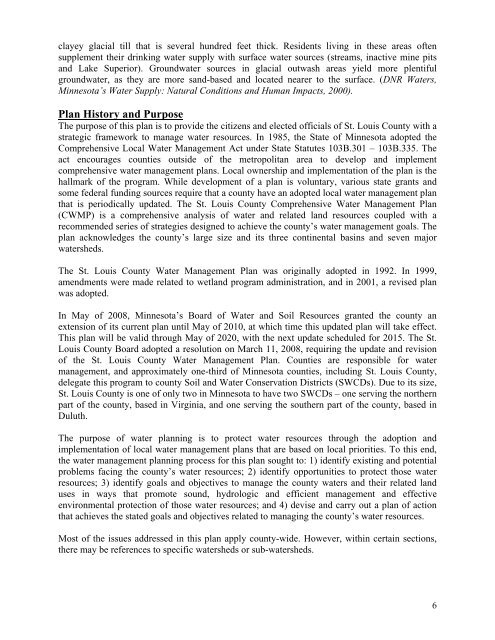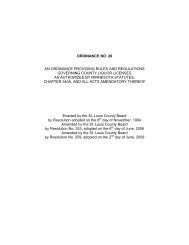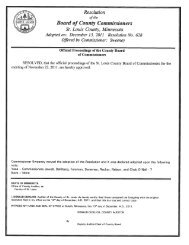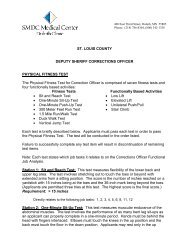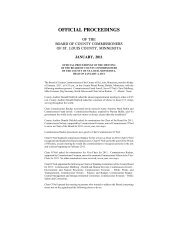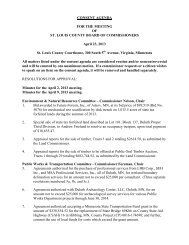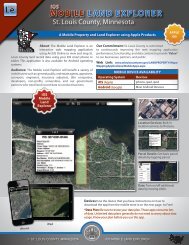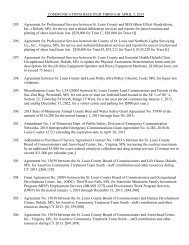Comprehensive Water Management Plan - St. Louis County
Comprehensive Water Management Plan - St. Louis County
Comprehensive Water Management Plan - St. Louis County
You also want an ePaper? Increase the reach of your titles
YUMPU automatically turns print PDFs into web optimized ePapers that Google loves.
clayey glacial till that is several hundred feet thick. Residents living in these areas oftensupplement their drinking water supply with surface water sources (streams, inactive mine pitsand Lake Superior). Groundwater sources in glacial outwash areas yield more plentifulgroundwater, as they are more sand-based and located nearer to the surface. (DNR <strong>Water</strong>s,Minnesota’s <strong>Water</strong> Supply: Natural Conditions and Human Impacts, 2000).<strong>Plan</strong> History and PurposeThe purpose of this plan is to provide the citizens and elected officials of <strong>St</strong>. <strong>Louis</strong> <strong>County</strong> with astrategic framework to manage water resources. In 1985, the <strong>St</strong>ate of Minnesota adopted the<strong>Comprehensive</strong> Local <strong>Water</strong> <strong>Management</strong> Act under <strong>St</strong>ate <strong>St</strong>atutes 103B.301 – 103B.335. Theact encourages counties outside of the metropolitan area to develop and implementcomprehensive water management plans. Local ownership and implementation of the plan is thehallmark of the program. While development of a plan is voluntary, various state grants andsome federal funding sources require that a county have an adopted local water management planthat is periodically updated. The <strong>St</strong>. <strong>Louis</strong> <strong>County</strong> <strong>Comprehensive</strong> <strong>Water</strong> <strong>Management</strong> <strong>Plan</strong>(CWMP) is a comprehensive analysis of water and related land resources coupled with arecommended series of strategies designed to achieve the county’s water management goals. Theplan acknowledges the county’s large size and its three continental basins and seven majorwatersheds.The <strong>St</strong>. <strong>Louis</strong> <strong>County</strong> <strong>Water</strong> <strong>Management</strong> <strong>Plan</strong> was originally adopted in 1992. In 1999,amendments were made related to wetland program administration, and in 2001, a revised planwas adopted.In May of 2008, Minnesota’s Board of <strong>Water</strong> and Soil Resources granted the county anextension of its current plan until May of 2010, at which time this updated plan will take effect.This plan will be valid through May of 2020, with the next update scheduled for 2015. The <strong>St</strong>.<strong>Louis</strong> <strong>County</strong> Board adopted a resolution on March 11, 2008, requiring the update and revisionof the <strong>St</strong>. <strong>Louis</strong> <strong>County</strong> <strong>Water</strong> <strong>Management</strong> <strong>Plan</strong>. Counties are responsible for watermanagement, and approximately one-third of Minnesota counties, including <strong>St</strong>. <strong>Louis</strong> <strong>County</strong>,delegate this program to county Soil and <strong>Water</strong> Conservation Districts (SWCDs). Due to its size,<strong>St</strong>. <strong>Louis</strong> <strong>County</strong> is one of only two in Minnesota to have two SWCDs – one serving the northernpart of the county, based in Virginia, and one serving the southern part of the county, based inDuluth.The purpose of water planning is to protect water resources through the adoption andimplementation of local water management plans that are based on local priorities. To this end,the water management planning process for this plan sought to: 1) identify existing and potentialproblems facing the county’s water resources; 2) identify opportunities to protect those waterresources; 3) identify goals and objectives to manage the county waters and their related landuses in ways that promote sound, hydrologic and efficient management and effectiveenvironmental protection of those water resources; and 4) devise and carry out a plan of actionthat achieves the stated goals and objectives related to managing the county’s water resources.Most of the issues addressed in this plan apply county-wide. However, within certain sections,there may be references to specific watersheds or sub-watersheds.6


